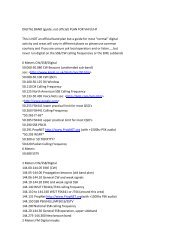You also want an ePaper? Increase the reach of your titles
YUMPU automatically turns print PDFs into web optimized ePapers that Google loves.
• (LEFT) Next we drill the interface cable exit<br />
• (RIGHT) Once the 3/8 inch hole is made, a pair of dikes can open the exit hole so the input/output cables can drop in.<br />
• (LEFT) I use wide "hook-N-loop" (Velcro) to attach the PCB inside the case. And.. if it ever becomes necessary to adjust the transmit ''coarse'' level, the<br />
''live hinge'' lid provides easy to access.<br />
• (RIGHT) Success and pride are so sweet. Now you're ready to plug-N-play.... <strong>PSK</strong>31, SSTV, MFSK, RTTY, sound card Packet and more!!!<br />
PRELIMINARY TESTS AND SETUP FOR <strong>PSK</strong>31 OPERATION:<br />
It is wise to build the interface PTT circuit first. This is the circuit that surrounds the IC (4N25, or 4N37). Once you have this part of<br />
the <strong>PSK</strong>31/SSTV PTT circuit around the IC (4N37) complete and working, the rest of the project is straightforward.<br />
Before you begin the interface transformer hookup, you should make sure the red LED comes on when the <strong>PSK</strong> program is placed<br />
into transmit mode. If it does not light up when program PTT is executed, then you should recheck your wiring. Make sure you have<br />
the PTT circuit working, before you proceed further.<br />
First, make sure the red LED is not installed backwards. The LONG lead of the LED should be wired towards the comport DB9 pin 7,<br />
RTS (DB25, pin 4). The short lead should be connected toward pin 1 of the IC. A resistor, (R1) may be in the LED short lead to pin 1<br />
of the IC. In which case, the other end of R1 connects to IC, pin 1. Pin two (2) of the IC connects to comport ground, or where the<br />
bare lead from the RS232 comport is attached. The Red LED should only illuminate (turn ON) when the <strong>PSK</strong>31 Program is placed<br />
into transmit. : * R1 resistor values may vary!!<br />
HOW TO TEST THE PTT CIRCUIT: * Resistor values may vary!!<br />
To test the circuit without having to load the software, and while you are at your work area, you can use a 9 volt battery and connect it<br />
across pin 5 “negative” and 7 “positive” of the DB9. (For a DB25, pin 7 is negative and pin 4 is positive) connector. Connect the<br />
negative terminal to DB9 pin 5, and positive terminal to DB9 pin 7; The Red LED should illuminate (turn ON)! Remove the 9 volts<br />
and the LED should turn OFF. To further test your PTT circuit action; With the 9 volt battery connected across DB9 pins 5 & 7,<br />
connect an ohmmeter, black lead (minus) to pin 4 of the IC, and the red (plus) lead to pin 5 of the IC. You should read a lower<br />
resistance when the 9 volt battery is connected. Remove the 9 volt battery from the DB9 connector (- to pin 5 and + to pin 7), and the<br />
ohmmeter should indicate an "open" (or high resistance) circuit. RTS means "Ready-To-Send" this is the signal on pin seven (7) of<br />
the DB9 that is executed when you enter “transmit” in your <strong>PSK</strong>31 program software. Using WIN<strong>PSK</strong> (supplied on the disk), go into<br />
the “SETTINGS” menu and using the GENERAL settings, set RTS active for PTT. Be sure to set the software to the comport in use<br />
by your <strong>PSK</strong> interface.<br />
22<br />
VISIT: www.BUXcommco.com



